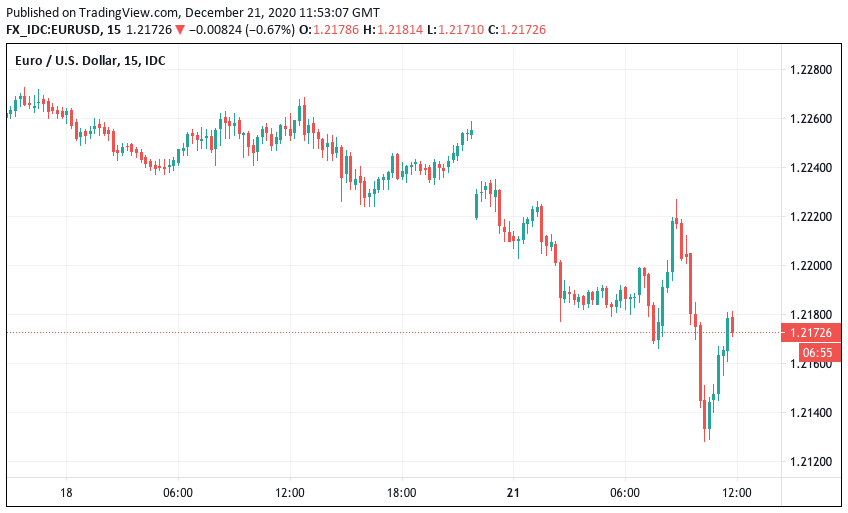Euro-Dollar Rate: 1.20 Could Come Back into View as Sentiment Suffers Setback

Image © European Central Bank
- EUR/USD spot rate at time of writing: 1.2175
- Bank transfer rate (indicative guide): 1.1750-1.1834
- FX specialist providers (indicative guide): 1.2090-1.2108
- More information on FX specialist rates here
An ugly start to the new week for global markets has meant investors have cut back exposure to equities and opted for cash, driving demand for the the U.S. Dollar which remains the world's default reserve currency and one of the main beneficiaries in times of market decline.
The Dollar index - a measure of broad Dollar performance based on a basket of Dollar exchange rates - rose by over a percent as investors gave a lacklustre reaction to the fiscal stimulus deal agreed by U.S. politicians overnight.
But it was a return of 'covid fear' that undermined stocks and sent the Dollar higher against the Euro, Pound and other major currencies after the UK reported a new variant of SARS-CoV-2 that appears to be more infections than other versions of the virus.
"USD is up across the board, equity markets are plunging, government bond yields are lower and crude oil prices are down. Concern a new and more infectious variant of the coronavirus discovered in the UK leads to stricter global lockdown measures is weighing on financial market risk sentiment," says Elias Haddad, Senior Currency Strategist at CBA.
The Euro-to-Dollar exchange rate is now down 0.65% since Sunday night's market open and is quoted at 1.2172, having been as high as 1.2270 on Friday.
"We still see risks to the risk-on rally in currency markets that is presently supporting all major and most emerging market currencies versus the USD. Markets are failing to reflect the economic lockdowns that are being initiated in response to renewed COVID-19 waves in the Northern Hemisphere. Currently, long-term enthusiasm is trumping short-term pain. So we think temporary setbacks are possible, and would offer an opportunity to unwind USD exposure," says Thomas Flury, Strategist, UBS Switzerland.
Above: EUR/USD since Friday.
The B.1.1.7. strain of SARS-CoV-2 (the virus which causes the covid-19 disease) is believed to have originated in the South East of England and scientists say it is up to 70% more contagious than other strains.
Underlining how scant information on the new variant still is, some reports out on Monday say it was first identified in Brazil earlier in the year.
"The risk from this strain is at the very worst that current vaccines may not prove as effective (this is as yet unknown), but at the very least that it makes any level of activity normalisation that much more difficult until vaccinations are sufficiently rolled out," says John Hardy, Head of FX Strategy at Saxo Bank.
It is important to stress the science and data on B.1.1.7. remains limited at this stage and it is therefore difficult to state any concrete conclusions about the variant, including how contagious it is.
Further scientific developments concerning the new strain could be made over coming days, which could either confirm the market's current dour sentiment or spark some relief.
Under such a relief scenario the Dollar would likely retreat once more.
The Euro's late-2020 rally nevertheless looks to have hit the buffers for now, and analysts are saying the 1.20 support level could fast come back into view.
"With EUR/USD already pressuring key tactical support near 1.2175, if this fails to hold, the bulls may beat a retreat to the key 1.2000 area," says Hardy.
{wbamp-hide start} {wbamp-hide end}{wbamp-show start}{wbamp-show end}
"EUR/USD is down over 0.8% just below the $1.22 handle this morning after rejecting the $1.2273 level the pair hit last week. Investors could profit take on longs this week given the recent news which could see the pair fall back towards the $1.20 which could offer some support for the pair heading into 2021," says Steven Colangelo, an analyst at Western Union.
The covid news coincides with developments on the fiscal support package agreed in the U.S. at the weekend; news markets had been eagerly awaiting.
The U.S. Congress agreed a $900BN stimulus package at the weekend, which is expected to be signed off by President Donald Trump before Christmas.
The new stimulus package includes $15BN for airlines, an extension of the $300/week supplemental jobless benefit and a $600 stimulus check.
"Congress may have finally agreed on a fiscal relief package but this morning the markets have been unable to rouse the enthusiasm to push higher," says Jane Foley, Senior FX Strategist at Rabobank. "The combination of over-crowded trades, the approach of year end and another wave of worrying news regarding Covid-19 has left stock markets mostly in the red overnight and futures trading lower."
Markets had long been anticipating a new round of fiscal stimulus, with some analysts saying a generous package could help stimulate equity markets higher and prompt further declines in the Dollar.
However, the package that was announced does not appear to be as ambitious as many had hoped, leading to a 'buy the rumour, sell the fact' reaction.
The Dollar is looking well poised to end 2020 on a stronger note.





